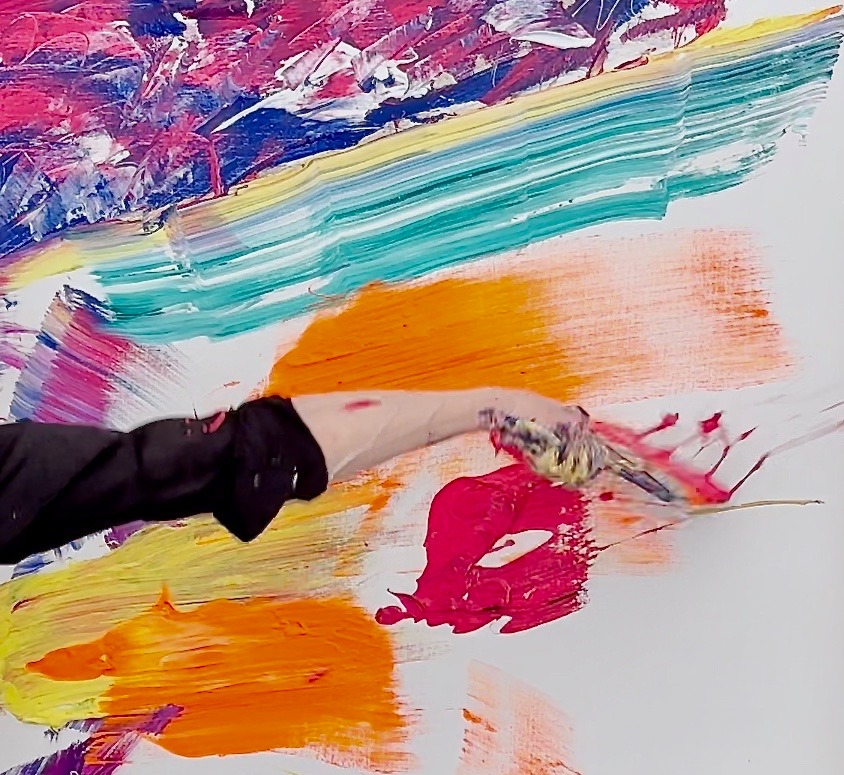
Awakening. musicpaintingLIVE
Pianist Reinis Zariņš & Painter Maryleen Schiltkamp. Hanzas Perons, June 17, 2023. Riga
On the evening of June 17, pianist Reinis Zariņš, together with Dutch painter Maryleen Schiltkamp, will execute an art synergy project – the live music/painting performance Awakening. The essence of the project is the fusion of painting and music: while Reinis Zariņš plays Igor Stravinsky’s The Rite of Spring, Maryleen Schiltkamp simultaneously visualises the music on canvas – the shared energy of both artists and the overlapping of sonic and visual elements creates a magical field where music and art become one. The result is a unique experience of sound, colour, form and movement; a transcendental moment in which the distinction between hearing and seeing disappears between the stroke of a brush and the pressing of the keys of a grand piano.
The project – incorporating the music originally written by Igor Stravinsky (b.1881, Oranienbaum; d.1971, New York) for the ballet The Rite of Spring into a live music/ painting performance – was a long-held dream of Zariņš and Schiltkamp, and has now become the highest point of their long-standing collaboration to date.
This multimedia performance is one of Arterritory.com’s projects in the EnergArt series, which focuses on the thought-provoking and healing power of art. Although Riga will be the starting point of the project, it is planned to move on to several other Latvian cities as well.
“Words tend to hurt, while art offers the possibility of entering a deep primordial state, a paradise that is not lost. Art can remind us how meaningful life is. We remember who we really are and, in doing so, we are perhaps healed,” says Reinis Zariņš.
The ability to let go of the moment; to transcend the known and to open oneself to new experiences, ideas, and dreams; to awaken creativity within oneself; to literally and figuratively access the Source where harmony pulsates – these are crucial in times of global turmoil and crisis. The interaction between the pianist and the painter also illustrates the need for collaboration as a basis for new ideas and development.
AWAKENING. Prelude Performed by pianist Reinis Zariņš
George Crumb – Makrokosmos I: I - Primeval Sounds (Genesis); Richard Wagner – Tristan and Isolde: Prelude; Frederic Rzewski – Winnsboro Cotton Mill Blues
Each of the piano works selected for the prelude expand and develop an aspect of Stravinsky’s The Rite of Spring: George Crumb creates a primeval soundscape symbolising the dark chaos before the awakening of order; with the fateful Tristan chord, Wagner not only begins an unforgettable story about fatal inevitability, but historically starts the age of modernism in music; and Rzewski’s blues send a message to the working class to wake and rise against their oppressors. In The Rite of Spring, there is also an awakening of people and nature; there is something prehistoric and foundational in its music – the shackles are to be thrown off, and there is the fateful inevitability of sacrificial death, from the very first note to the last.
AWAKENING. The centre
Igor Stravinsky – The Rite of Spring (version for a pianist and a painter)
Pianist Reinis Zariņš and painter Maryleen Schiltkamp’s interpretation of Igor Stravinsky’s The Rite of Spring is a high-intensity performance that engages both artists as directly as possible. They experience the music as an unstoppable force that pulls at them, demanding everything from the artist. The result is a unique interaction between the pianist, who plays Stravinsky’s massive orchestral score alone, and the painter, whose choreography of brushes and paints on a large-scale canvas reveals the deeply rooted essence of The Rite of Spring. Stravinsky intended to visualise the spring awakening ceremony through dance. The primal rituals displayed are like games – circle dances, tribal rivalries, the honouring of the elders – yet they culminate in a stunning sacrificial dance performed by the Chosen One.
During the performance, the pianist and the painter together create a work of art in which the senses of hearing and sight overlap. For the pianist, the music takes on colour, while the painter, letting herself be carried along by the vibrations of the sound waves, performs/interprets/physically experiences it with her brush on the canvas. She makes the music material.
Arterritory is grateful to Leon Zilber, Agita and Andris Putans, and Iveta and Harijs Briedis for their kind support to make this event happen.